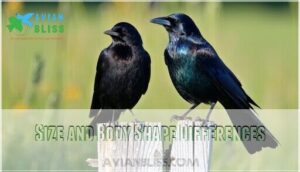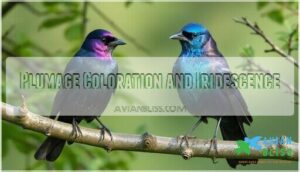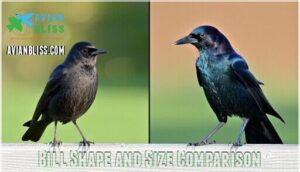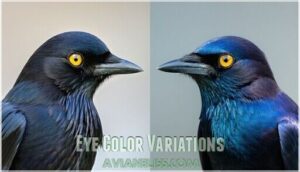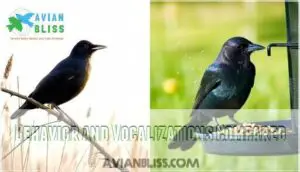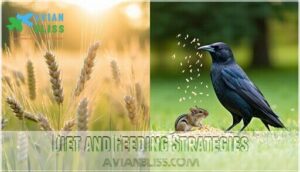This site is supported by our readers. We may earn a commission, at no cost to you, if you purchase through links.
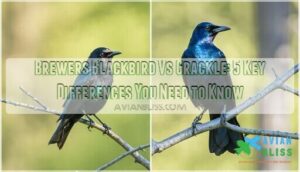
Male grackles show bluish heads and bronzy bodies while male Brewer’s blackbirds have purple head shimmer and greenish body iridescence.
Grackles prefer eastern woodlands and agricultural areas. Brewer’s blackbirds stick to western grasslands and coastal regions.
The weight difference is noticeable too – grackles weigh up to 5 ounces compared to Brewer’s blackbirds at 2.2 ounces. These field marks make identification much easier than you’d expect.
Table Of Contents
- Key Takeaways
- Physical Differences: Brewer’s Blackbird Vs Grackle
- Habitat Preferences and Geographic Ranges
- Behavior and Vocalizations Compared
- Diet and Feeding Strategies
- Conservation, Population Trends, and Human Interactions
- Frequently Asked Questions (FAQs)
- How do I identify a brewer’s blackbird?
- How to tell a blackbird from a grackle?
- What is the difference between a starling and a Brewer’s blackbird?
- What is the difference between a Brewer’s blackbird and a rusty blackbird?
- Can Brewers Blackbirds and Grackles be kept as pets?
- How do Brewers Blackbirds and Grackles respond to predators?
- What are common parasites found in Brewers Blackbirds and Grackles?
- Can Brewers Blackbirds and Grackles recognize individual humans?
- How do Brewers Blackbirds and Grackles adapt to harsh weather?
- When do these blackbirds typically migrate?
Key Takeaways
- You’ll easily spot the size difference – grackles are larger at 11-13 inches with heavy bills, while Brewer’s blackbirds are compact at 9 inches with straight bills.
- You can distinguish males by their iridescence – Brewer’s blackbirds show purple head shimmer and greenish bodies, while grackles display bluish heads and bronzy bodies.
- You’ll find them in different regions – Brewer’s blackbirds prefer western grasslands and coastal areas, while grackles stick to eastern woodlands and agricultural zones.
- You’ll notice their weight difference when handling – grackles weigh up to 5 ounces compared to Brewer’s blackbirds at just 2.2 ounces.
Physical Differences: Brewer’s Blackbird Vs Grackle
You’ll notice distinct physical features when comparing these two blackbird species. Brewer’s Blackbirds are medium-sized with shorter tails and straight bills, while Common Grackles are larger birds with long tails and heavy bills.
Size and Body Shape Differences
When comparing these blackbird species side-by-side, you’ll notice grackles tower over Brewers Blackbirds. Common Grackles are larger than Brewer’s Blackbirds with a longer tail and a heavier bill, while Brewer’s Blackbirds are relatively smaller, with a compact body structure. Brewers Blackbirds average 9 inches long with a 15.5-inch wingspan. Both species display omnivorous feeding behavior, consuming a wide array of food.
| Feature | Brewer’s Blackbird | Grackle |
|---|---|---|
| Length Measurements | 9 inches | 11-13 inches |
| Weight Comparison | 2.2 ounces | 2.6-5 ounces |
| Skeletal Structure | Compact build | Elongated body |
| Bill Shape | Straight bill | Heavy bill |
Plumage Coloration and Iridescence
You’ll notice the plumage differences right away. Male Brewer’s Blackbirds show glossy black feathers with purple iridescence on the head and greenish body shimmer. Grackles display bluish heads and bronzy bodies under good lighting. Female Brewer’s appear grayish-brown and plain, while grackle females stay brownish but glossier. The Brewer’s Blackbird is classified as a Least Concern species on the IUCN Red List.
| Feature | Brewer’s Blackbird | Common Grackle |
|---|---|---|
| Male Head Color | Purple iridescence | Bluish iridescence |
| Male Body Color | Greenish shimmer | Bronzy/greenish |
| Female Plumage | Plain grayish-brown | Brownish, glossy |
Bill Shape and Size Comparison
Looking at their bills tells you everything about how these birds make a living. Grackles pack heavy, robust bills that can tackle just about anything, while Brewer’s Blackbirds sport slender, needle-sharp bills built for precision work.
It’s like comparing a Swiss Army knife to a surgeon’s scalpel—each bird evolved exactly what it needed to thrive in its niche.
Each blackbird species evolved specialized tools perfectly matched to their hunting style and ecological niche
| Feature | Brewer’s Blackbird | Common Grackle |
|---|---|---|
| Bill Length | Shorter, pointed bill | Longer, heavier bill |
| Shape | Straight bill profile | More sturdy structure |
| Function | Insect specialization | Omnivorous versatility |
Eye Color Variations
You’ll spot the most striking difference in their eyes when comparing these species. Male Brewer’s Blackbirds display bright yellow eyes that pierce through their dark plumage, while females generally show dark brown eyes . Occasionally, female Brewer’s Blackbirds have pale yellow eyes , creating variation within the species. Common Grackles also show piercing yellow eyes in males, making eye color a challenging identification feature.
| Feature | Brewer’s Blackbird | Common Grackle |
|---|---|---|
| Male Eye Color | Bright yellow | Piercing yellow |
| Female Eye Color | Dark brown (occasionally pale) | Dark brown to yellow |
| Juvenile Eye Color | Dark brown | Dark brown |
| Regional Eye Differences | Minimal variation | Some geographic variation |
| Eye Color Mutations | Rare pale females | Uncommon variations |
Tail Length and Shape Distinctions
You’ll notice the tail shape differences immediately. Grackles have longer tails than Brewer’s blackbirds. Grackles hold their long tail in a deeply keeled wedge-shaped tail. Brewer’s blackbirds have shorter tails that appear more squared-off at the end. This tail function helps with identification.
| Feature | Grackle | Brewer’s Blackbird |
|---|---|---|
| Tail Length | Longer | Shorter |
| Tail Shape | Wedgeshaped | Squared-off |
| Feather Arrangement | Keeled/rudder-like | Flat profile |
Habitat Preferences and Geographic Ranges
You’ll find these birds in surprisingly different places across North America. Brewer’s Blackbirds prefer open western habitats like grasslands and coastal areas, while Common Grackles favor eastern woodlands and agricultural regions.
Typical Habitats for Brewer’s Blackbird
You’ll find Brewer’s Blackbirds thriving in diverse open landscapes across western North America. These adaptable birds prefer habitat diversity that helps their opportunistic lifestyle. Their foraging locations span from natural grasslands to human-modified environments.
Key habitats include:
- Coastal habitats – scrublands and beaches where ocean meets land
- Agricultural fields and meadows with scattered perches
- Urban habitats – parking lots, golf courses, and city parks
- Open grasslands with minimal tree cover for ground foraging
Common Grackle Habitat Choices
Common
Overlapping and Distinct Geographic Ranges
Where blackbird territories meet, you’ll find some interesting dynamics at play. These range overlap zones become battlegrounds for the best spots, and each species has carved out its niche. Common grackles? They’ve claimed the urban jungle—your parking lots, city parks, and suburban neighborhoods. Meanwhile, Brewer’s blackbirds stick to what they know best: wide-open spaces like farmland and prairie.
- Range overlap zones happen mostly across the Great Plains and farm country
- Common grackle territory spans east of the Rockies, especially in towns and cities
- Brewer’s blackbird calls the open country west of the Mississippi home
- Climate change impact keeps pushing both species further north and east
- Regional abundance factors include having to compete with great-tailed grackles down south
This territorial split makes perfect sense when you think about their different lifestyles and what each species needs to thrive.
Behavior and Vocalizations Compared
You’ll notice striking differences when you observe how these blackbirds behave and communicate in the wild. Brewer’s Blackbirds show more opportunistic foraging patterns and produce simpler calls, while Grackles display aggressive feeder behavior and create complex vocalizations with varied tones.
Foraging Behaviors and Techniques
You’ll notice dramatic differences between these species’ foraging behavior. Brewer’s Blackbirds demonstrate opportunistic feeding by following farm machinery to catch exposed insects, while grackles exhibit aggressive scavenging behavior and even steal food from other birds.
Their dietary adaptations reflect habitat needs—Brewer’s focus on insect predation during breeding season, while grackles practice winter foraging across diverse food sources.
Brewer’s Blackbird Calls and Songs
Brewer’s Blackbirds sound nothing like the songbirds you might expect. Instead of sweet melodies, they produce harsh, scratchy calls that stand out in any bird chorus. Their breeding songs are simple and raspy, usually lasting just 2-3 seconds.
You’ll hear four main types of sounds from these birds:
- Sharp alarm calls – Quick "check" notes when they spot danger
- Basic songs – Those rough, scratchy phrases during breeding season
- Contact calls – Softer sounds that keep the flock together while they forage
- Limited dialects – Unlike many birds, these blackbirds sound pretty much the same everywhere you find them
- Regional dialects – Minimal variation across Blackbird habitat ranges
While Brewer’s Blackbirds stick to simple chirping, grackles are the chatterboxes of the blackbird world. These birds have mastered everything from harsh, guttural squeaks to piercing whistles that can make your ears ring.
Scientists studying their calls found grackles use frequencies between 2–8 kHz, and here’s the interesting part – different grackle populations have developed their own local "accents." What really sets them apart is their knack for mimicking sounds around them, making them stand out from their quieter blackbird relatives.
Unlike the subtle chirping of Brewer’s Blackbirds, grackles possess an extensive grackle vocal repertoire featuring harsh guttural squeaks and highpitched whistles. Sound frequency analysis reveals grackle vocalizations span 2-8 kHz, with regional dialect variations across populations. Their communication complexity includes vocal mimicry abilities that distinguish these grackle characteristics from other blackbirds.
Social Interactions and Flock Dynamics
When observing these birds together, you’ll notice stark differences in their social dynamics. Grackles form large, hierarchical flocks with complex mating displays and cooperative foraging patterns. They exhibit strong social learning behaviors, especially in juvenile grackles during their life cycle development.
Brewer’s Blackbirds maintain simpler flock structures with less pronounced hierarchy and more independent foraging strategies for predator avoidance.
Diet and Feeding Strategies
You’ll discover that these blackbirds show striking differences in their food choices and feeding methods. Brewer’s Blackbirds focus mainly on insects during breeding season but switch to seeds and grains in winter, while Grackles eat almost everything, including small animals, and use aggressive tactics at feeders.
Brewer’s Blackbirds are remarkably flexible eaters, switching up their diet as seasons change. You’ll find them hopping around different spots year-round, always following where the food is.
- Insect consumption peaks during breeding season for protein-rich nutrition
- Seasonal diet shifts from insects to grains and seeds in winter
- Foraging locations include grasslands, parking lots, and agricultural fields
- Crop pest control benefits farmers by reducing harmful insects
- Dietary adaptations allow survival in diverse blackbird habitat conditions
- Crop pest control benefits farmers by reducing harmful insects
- Dietary adaptations allow survival in diverse blackbird habitat conditions
When grackles show up, they mean business. These birds push smaller species around at feeders, using their size to get what they want. They’ll eat just about anything – bugs, seeds, even your trash if you’re not careful.
These clever birds have figured out something interesting: they grab ants and rub them all over their feathers. Sounds weird, but it actually helps keep other pests away. Living in cities and suburbs has made grackles pretty adaptable too. They switch up their feeding habits depending on what’s available each season and where they happen to be nesting.
When grackles show up, they mean business. These birds demonstrate aggressive foraging behavior at feeders, dominating smaller species through sheer size. Their omnivorous diet includes everything from insects and seeds to garbage.
Grackles practice unique anting behavior, rubbing ants on feathers for pest control. Urban adaptations allow seasonal variation in feeding strategies throughout different grackle habitat types.
Impact on Agricultural Crops
Both species greatly impact agricultural systems through their feeding patterns. While grackles often damage crops more extensively, both birds also provide important ecological services to farmers.
- Crop damage assessment – Grackles cause greater losses to corn and grain crops than Brewer’s blackbirds
- Pest control benefits – Adult male and juvenile birds consume harmful insects during breeding season
- Seed dispersal roles – Both species spread seeds across agricultural landscapes
- Fertilizer distribution – Their droppings enrich soil nutrients in farm areas
Conservation, Population Trends, and Human Interactions
You’ll find that both species face significant population challenges despite their protected status under federal law. Common Grackles show steeper declines at 3% annually with a 78% drop since 1970, while Brewer’s Blackbirds decline at 2% per year due to shooting and agricultural poisoning.
Current Conservation Status
Researchers keep tracking these bird traits through identification programs across the country.
Both species maintain stable Protected Status under current bird identification standards. Brewer’s blackbirds are classified as a species of "Least Concern" by the International Union for Conservation of Nature (IUCN), while Common Grackles received "Near Threatened" status recently, citing a large-scale decline of more than 60 percent over 40 years.
Conservation Efforts continue monitoring these avian characteristics through bird identification guide programs nationwide.
Population Declines and Threats
Both species face significant population pressures from Human Impact and Habitat Loss. Common Grackles have dropped 78% since 1970, while Brewer’s Blackbirds decline 2% annually.
Population Drivers include agricultural conflicts, pesticide exposure, and window collisions.
Conservation Efforts focus on Mitigation Strategies like protected breeding areas, though challenges persist from culling programs targeting these birds.
Urban Adaptation and Backyard Behavior
Both species adapt well to city life, though they show different patterns. Grackles dominating feeders with aggressive behavior, while Brewer’s Blackbirds prefer ground foraging around human activity.
Grackles tolerate loud urban noise better and nest in taller structures. Brewer’s Blackbirds choose lower nesting sites but handle human proximity exceptionally well, making them common on sidewalks and parking lots where urban foraging opportunities abound.
Birding Tips for Accurate Identification
When identifying these birds in the field, pay attention to key distinguishing features. Check plumage lighting for iridescence differences – grackles show bronze-blue sheens while Brewer’s display purple-green tones. Listen for vocalization cues: grackles produce harsh squeaks, Brewer’s offer melodic warbles.
Consider habitat context and seasonal changes affecting appearance. Study behavior patterns like tail positioning and walking styles.
Use a bird identification guide to compare blackbird physical characteristics and grackle physical descriptions, noting plumage variations between species.
Frequently Asked Questions (FAQs)
How do I identify a brewer’s blackbird?
Look for a medium-sized blackbird with glossy black plumage and purple head sheen. Males have piercing yellow eyes, straight bills, and shorter tails than grackles. You’ll spot them in open areas like parks and fields.
How to tell a blackbird from a grackle?
Don’t worry—while blackbirds can be tricky, you’ll spot the differences with practice. Grackles are larger with longer tails and heavier bills. They have bright yellow eyes and iridescent purple-blue heads.
Blackbirds appear smaller with shorter tails.
What is the difference between a starling and a Brewer’s blackbird?
Starlings have chunky bodies with short, squared tails and long, pointed bills that turn yellow in breeding season.
Brewer’s blackbirds are sleeker with longer tails and straight bills that stay dark year-round.
What is the difference between a Brewer’s blackbird and a rusty blackbird?
You’ll spot key differences between Brewer’s and rusty blackbirds through habitat and markings. Rusty blackbirds prefer wet, swampy areas while Brewer’s have shorter bills and iridescent purple heads on males. Nonbreeding rusty blackbirds show distinctive rusty markings.
Can Brewers Blackbirds and Grackles be kept as pets?
While you might think keeping these smart birds sounds fun, you can’t legally own Brewer’s Blackbirds or Grackles as pets.
The Migratory Bird Treaty Act prohibits possession of these protected species. It’s actually federal law.
How do Brewers Blackbirds and Grackles respond to predators?
You’ll see both species use similar defense tactics when predators threaten. Brewer’s blackbirds dive at threats and emit alarm calls, while grackles actively defend nests by mobbing, chasing, or diving at predators.
Both birds mob aggressively.
What are common parasites found in Brewers Blackbirds and Grackles?
These feathered friends carry unwelcome passengers. You’ll find external mites, lice, and ticks affecting both species.
Brewer’s blackbirds host mosquito-borne viruses like St. Louis encephalitis and western equine encephalitis. Grackles suffer from filarial nematodes including Chandlerella quiscali affecting their brains.
Can Brewers Blackbirds and Grackles recognize individual humans?
Research shows you’re right to wonder! Both species likely can recognize individual humans through facial features and voices, though Grackles have stronger documented evidence with some studies confirming they remember specific people and their behaviors toward them.
How do Brewers Blackbirds and Grackles adapt to harsh weather?
You’ll watch both species huddle together in massive communal roosts during winter storms.
They select dense trees or sheltered areas that block wind and retain heat, while fluffing their feathers for extra insulation.
When do these blackbirds typically migrate?
October marks peak migration time for these blackbirds. Grackles begin spring migration in February and March, while fall migration peaks around October or November.
Brewer’s Blackbirds migrate north relatively early in spring and spread eastward during fall.
Ever tried telling a Brewer’s blackbird from a grackle in the field? It’s trickier than you might think, but a few key details make all the difference.
Size gives you the first clue—grackles stretch 11–13 inches, while Brewer’s blackbirds clock in around 9 inches. Once you notice that difference, check the bill shape and how the light catches their feathers. Each species has its own iridescence pattern.
These birds also hang out in different spots, so habitat can tip you off too. Master these identification tricks, and you’ll never second-guess yourself on your next birding trip.
Size differences stand out immediately, with grackles measuring 11-13 inches compared to Brewer’s blackbirds at 9 inches. Bill shape, iridescence patterns, and habitat preferences provide additional identification clues.
These systematic observation techniques help with accurate species identification during your next birding adventure.
- https://en.wikipedia.org/wiki/Common_grackle
- https://www.allaboutbirds.org/guide/Common_Grackle/species-compare/
- https://dnr.illinois.gov/education/wildaboutpages/wildaboutbirds/wildaboutbirdsblackbirds/wabbrewersblackbird.html
- https://animaldiversity.org/accounts/Euphagus_cyanocephalus/
- https://www.aphis.usda.gov/sites/default/files/Grackles_WDM%20Technical%20Series_April%202020.pdf

